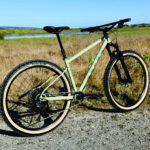Specialized Turbo Levo Comp Alloy
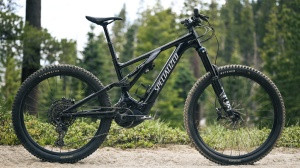 Specialized Turbo Levo Comp Alloy best overall e mountain bike
Specialized Turbo Levo Comp Alloy best overall e mountain bike
87
OVERALL SCORE
- Downhill Performance 9.0
- Climbing Performance 8.0
- Measured Effective Range 9.0
- Power Output 9.0
- E-Bike Controls 7.0
REASONS TO BUY
700Wh battery
Highly adjustable geometry
Intuitive operation
Excellent range
REASONS TO AVOID
Stock tires could be tougher
Fork not specifically designed for e-bikes
Brakes could be more powerful
Battery size not leading the market anymore
SPECIFICATIONS
| Wheel size (inches) | MX (29″ front, 27.5″ rear) |
|---|---|
| Battery Size (Wh) | 700Wh |
| Motor System | Specialized Turbo Full Power 2.2 |
| Motor Power (torque) | 90Nm |
| Measured Weight (w/o pedals) | 51 lbs 3 oz (S4) |
For the fourth consecutive year, the Specialized Turbo Levo Comp Alloy secures the top position as the best overall e-mountain bike. According to our lead tester, Joshua Hutchens, it stands out as “just the most fun to ride.” A key feature is its highly adjustable geometry, offering six distinct configurations through adjustable headset cups and chainstay flip chips. The headset cups allow for head tube angle adjustments in full-degree increments, ranging from 65.5 to 63.5 degrees. The flip chips adjust the bottom bracket height by 7mm between high and low settings. Joshua highlights that “this unprecedented adjustability lets riders tailor the bike to their specific riding style, terrain, and preferences, elevating the Levo’s versatility.”
The move to a mixed wheel size setup enhances the bike’s maneuverability in the rear and improves clearance on steep slopes. The 700Wh battery, carried over from the previous model, delivers an impressive 33.1-mile range. Only the Canyon Spectral:ON CF 8, equipped with a 900Wh battery, surpassed it in range. The motor delivers significant torque with three customizable support modes. The system’s refinement and seamless integration are notable, and the Comp Alloy model provides a functional and capable component package, despite not being overly flashy. Its current discounted price makes it an exceptional value in the full suspension E-MTB category. While the Ari Wire Peak 2.0 Comp is cheaper, it offers considerably less performance.
While the Turbo Levo Comp excels in many areas, there are minor areas for potential improvement. A handlebar-mounted digital display could be a beneficial addition, although the top tube-mounted TCU already provides ample data while maintaining a clean cockpit. The SRAM Code R brakes on our test bike were adequate but became spongy and inconsistent during extended descents due to heat buildup. Although we appreciate Specialized’s tire treads, the stock GRID Trail casings are not robust enough for the bike’s weight and aggressive capabilities. Despite these minor points, the Specialized remained the test team’s preferred model due to its enhanced versatility from adjustable geometry, well-rounded performance, and impressive range and efficiency. Our team collectively owns several Levos, from S-works to Comp models, finding them to be incredible bikes offering great value. We’ve also experienced motor replacements, but the warranty process has been excellent.
Read more: Specialized Turbo Levo Comp Alloy review
 Specialized Turbo Levo Comp Alloy best overall e mountain bike
Specialized Turbo Levo Comp Alloy best overall e mountain bike
Riding Specialized’s Turbo Levo Comp deep into the Sierras for all weekend testing.
Credit: Gabriel Amadeus Tiller
Best for Range
Canyon Spectral:ON CF 8
85
OVERALL SCORE
- Downhill Performance 8.0
- Climbing Performance 8.0
- Measured Effective Range 10.0
- Power Output 8.0
- E-Bike Controls 8.0
REASONS TO BUY
Very competitive price
High-quality components
Carbon frame
Well-rounded performance
Massive battery for excellent range
REASONS TO AVOID
Reduced ground clearance due to motor/battery bulge
Fork not specifically designed for e-bikes and feels flexy
Stock tires could benefit from tougher casings
SPECIFICATIONS
| Wheel size (inches) | MX (29″ front, 27.5″ rear) |
|---|---|
| Battery Size (Wh) | 900Wh |
| Motor System | Shimano EP8 |
| Motor Power (torque) | 85Nm |
| Measured Weight (w/o pedals) | 51 lbs 15 oz (Large) |
The Canyon Spectral:ON CF 8 impressed us significantly. It features mixed wheel sizes, 155/150mm of travel, modern trail geometry, and a full carbon frame that houses a massive 900Wh battery. Tester Chris McNamara noted, “I could ride nearly 10,000 vertical feet in eco mode, surpassing the range of any E-MTB I’ve ever tested.” The Shimano EP8 motor is angled to accommodate the large battery and positioned to maintain a low center of gravity. This results in a remarkably balanced and maneuverable bike, despite its considerable weight. It offers exceptional stability and ample travel to confidently tackle challenging terrain, while remaining manageable on less demanding trails. The trail riding geometry provides a good balance of climbing comfort, agility, and overall versatility. The high-quality component package further enhances its performance. And the standout feature: the 900Wh battery eliminates range anxiety, ensuring the rider’s endurance is the limiting factor, not battery life. Canyon’s direct-to-consumer sales model allows them to offer this bike at a very competitive price, making it an excellent value proposition.
However, the Spectral:ON CF 8 isn’t without minor drawbacks. While the 900Wh battery is a significant advantage, the resulting bulge below the bottom bracket reduces ground clearance, which can be problematic in technical sections. Combined with a relatively low bottom bracket height, this can be challenging in certain situations. Although we generally favor the Fox 36 Rhythm fork, the bike’s weight would be better supported by a sturdier 38 model, as the 36 felt somewhat flexy under braking and in rough terrain. While we like the Maxxis Minion DHR II and Assegai tire combination, the EXO+ and EXO casings, respectively, are not sufficiently robust for the weight and capabilities of the Spectral:ON. Tire upgrades are relatively inexpensive, but premature tire or rim damage is undesirable. Aside from these points, it’s hard to find a superior electric mountain bike, especially at this price point.
Read more: Canyon Spectral:ON CF 8 review
 Specialized Turbo Levo Comp Alloy best overall e mountain bike
Specialized Turbo Levo Comp Alloy best overall e mountain bike
The Spectral:ON has the range to keep the party going all day.
Credit: Joshua Hutchens
Best Bang for the Buck
Aventon Ramblas
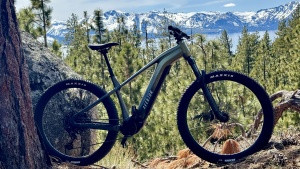 Aventon Ramblas best value e mountain bike
Aventon Ramblas best value e mountain bike
80
OVERALL SCORE
- Downhill Performance 7.0
- Climbing Performance 7.0
- Measured Effective Range 9.0
- Power Output 10.0
- E-Bike Controls 8.0
REASONS TO BUY
Exceptional value for money
Impressive range
Incredibly powerful motor
REASONS TO AVOID
Relatively heavy
Non-adjustable fork limits customization
Integrated tail lights might be unnecessary for some
SPECIFICATIONS
| Wheel size (inches) | 29 |
|---|---|
| Battery Size (Wh) | 708Wh |
| Motor System | Aventon A100 |
| Motor Power (torque) | 100Nm |
| Measured Weight (w/o pedals) | 54 lbs (Large) |
Aventon, primarily known for city and commuter e-bikes, is making a significant entry into the mountain bike scene with the new Ramblas and its Aventon A100 motor. The Ramblas boasts a compelling component package and an even more appealing price tag, making it the best bang for your buck e-mountain bike. The build includes a RockShox 35 Silver fork, SRAM NX Eagle drivetrain, SRAM DB8 brakes, a dropper post, and Maxxis tires. A removable 708Wh battery is neatly integrated into the downtube and powers the high-torque motor. This is the most affordable e-MTB we’ve tested and also the most powerful, registering over 26Nm of torque at the rear wheel in our dynamometer test. Lead tester Joshua stated, “Most E-MTB models climb at roughly the same speed in turbo mode. The Ramblas simply outpaced them all.”
An aluminum frame, 29″ wheels, a 130mm coil-sprung fork, and slightly conservative modern geometry contribute to the bike’s versatility. While the component spec alone is attractive, the Ramblas offers more than just a sum of its parts. It’s remarkably fun and powerful. Even when ridden alongside other e-bikes, the Ramblas excels in cross-country terrain. The direct-to-consumer model translates to significant cost savings, and Aventon is poised to capture a large market with this model, offering four frame sizes, with the smallest utilizing 27.5″ wheels to accommodate riders as short as 5’1″.
The ride quality is firm, and customization is limited; the fork lacks adjustability, and the rims are not tubeless-compatible. Aggressive trail riders might find the comfort lacking. However, this e-MTB’s appeal extends beyond trail riding. Equipped with integrated tail lights in the chainstays, a bright headlight, and a kickstand mount, it caters to riders seeking versatility with a mountain bike foundation.
Weighing in at 54 lbs, it’s not lightweight, but the motor’s ample power effectively compensates for the mass. In our range test, the Ramblas covered 30.1 miles with 5980 feet of vertical ascent on a single charge, proving its efficiency. Powerful, capable, and affordably priced, the Ramblas is a standout value proposition in the e-MTB market.
Read more: Aventon Ramblas review
 Aventon Ramblas best value e mountain bike
Aventon Ramblas best value e mountain bike
A spectacular value that is highly versatile and incredibly powerful.
Credit: Matt Lighthart
Best Lightweight e-mountain bike
Specialized Turbo Levo SL Comp
76
OVERALL SCORE
- Downhill Performance 9.0
- Climbing Performance 8.0
- Measured Effective Range 6.0
- Power Output 6.0
- E-Bike Controls 10.0
REASONS TO BUY
Trail bike-like ride quality
Excellent system integration
Lightweight design
Optional range extender battery
REASONS TO AVOID
Higher price point
SPECIFICATIONS
| Wheel size (inches) | MX (29″ front, 27.5″ rear) |
|---|---|
| Battery Size (Wh) | 320Wh (+160Wh Range Extender) |
| Motor System | Specialized SL 1.2 (320W) |
| Motor Power (torque) | 50Nm |
| Measured Weight (w/o pedals) | 40 lbs 1 oz (S4)(2lbs 6 oz – range extender battery) |
The redesigned Specialized Turbo Levo SL Comp is a mid-power electric trail bike that offers a ride feel closer to a traditional trail bike than a typical e-bike, making it the best lightweight e-mountain bike. Built with Specialized’s next-generation SL 1.2 motor and a 320Wh battery, it enhances rides with added power, speed, and torque. The motor’s 50Nm of torque provides assistance without the overwhelming power of the standard Levo’s 90Nm. Instead, the Levo SL strikes a balance between assist and weight, weighing over 5 pounds less than the similarly priced alloy Trek Fuel EXe 8 GX AXS Transmission. These two bikes are often compared by those seeking a mid-power trail e-bike due to their remarkable similarities. The Specialized excels with its lighter weight, significant adjustability, and user-friendly interface. It performed exceptionally well in downhill testing; the slacker (and adjustable) headtube angle improved high-speed handling, and the shorter 432mm chainstays provided a playful and agile feel. In technical situations, the bike’s lighter weight contributed to a nimble character absent in most heavier e-mountain bikes. The power delivery feels natural, seamlessly augmenting the rider’s input, enhancing athleticism without completely negating the workout. While it scores lower in power output tests, the 320 watts of Turbo assist significantly changes the ride dynamic while still allowing for a solid cardio workout.
The FACT 11M carbon frame and Fox suspension work in harmony to deliver a comfortable and responsive ride. The SRAM drivetrain offers good performance for the price point, and while the Transmission drivetrain offers greater precision, the $2000 price jump doesn’t feel justified. This build hits a sweet spot of performance and value. Although Specialized offers an alloy model, it’s only marginally cheaper and heavier. We also tested this bike with a 29″ rear wheel, resulting in a more efficient but less playful ride feel. At just over 40 pounds, testers appreciated the lightweight feel, enabling enjoyable rides even without motor assistance.
Read more: Specialized Turbo Levo SL Comp review
 Aventon Ramblas best value e mountain bike
Aventon Ramblas best value e mountain bike
A fantastic trail bike that just happens to have a motor.
Credit: Matt Lighthart
Compare Products
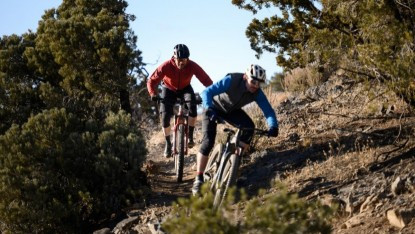 Riders testing best new electric mountain bikes
Riders testing best new electric mountain bikes
Out for a rip while testing the best new electric mountain bikes.
Credit: Laura Casner
How We Test Electric Mountain Bikes
Over several months, our team of experienced mountain bike testers subjected each e-mountain bike in our selection to rigorous testing across diverse trails and terrains in varying climates. Each tester rode each bike extensively, often comparing models back-to-back for direct assessment. We pushed these bikes to their limits, treating them as our own to thoroughly identify their strengths and weaknesses. Our comprehensive testing methodology is detailed further here.
Our testing protocol encompasses five key rating metrics:
- Downhill Performance tests (30% of overall score weighting)
- Climbing Performance tests (25% weighting)
- Distance Range tests (25% weighting)
- Power Output tests (15% weighting)
- E-Bike Controls tests (5% weighting)
This multi-point performance analysis evaluates each bike both as a mountain bike and as an e-bike. We’ve accumulated hundreds of miles on these bikes, conducting numerous tests to accurately assess and compare their performance. Downhill performance is weighted most heavily (35% of the total score) as we consider it the most critical aspect of a mountain bike’s functionality.
Why Trust GearLab
Our test team comprises individuals with extensive backgrounds in the bike industry. These are experienced racers, mechanics, bike shop owners, and passionate adventure riders.
Joshua Hutchens has decades of experience in the cycling industry, including roles as a racer, bike shop owner, mechanic, and guide. Beyond testing, Joshua shares his passion for mountain biking by teaching kids through his local community college. He possesses a keen eye for mountain bike performance nuances and particularly enjoys airborne maneuvers. His favorite trails include Highline in Sedona and A-Line in Whistler. Jeremy Benson is deeply immersed in the mountain biking world. A New England native, he started mountain biking in 1992 and began racing in 1999. Relocating to Tahoe fueled his riding obsession, and he continues to compete, achieving impressive results at events like the Downieville Classic and the Lost and Found Gravel Grinder. Jeremy is also the author of Mountain Bike Tahoe, published in 2017. Kurt Gensheimer is a seasoned bike industry veteran and freelance writer. He brings decades of bike testing expertise and a passion for exploring remote areas of the Lost Sierra on electric mountain bikes. A former singlespeed rider, he’s also known as the Angry Single Speeder. Chris McNamara dedicates significant time to riding. This rock climber turned mountain biker enjoys long-distance rides. He is currently planning ambitious routes, including a singletrack circuit around Lake Tahoe and a ride from Canada to Cabo San Lucas.
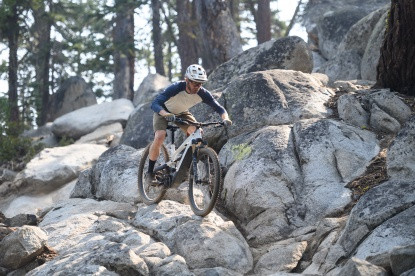 Testing e mountain bikes near Lake Tahoe CA
Testing e mountain bikes near Lake Tahoe CA
Testing electric mountain bikes on moto legal trails near Lake Tahoe, CA.
Credit: Laura Casner
How to Choose the Best Electric Mountain Bike
Finding the ideal bike can be challenging, and the addition of a motor to the equation can make the process seem even more complex. We aim to simplify this by highlighting key considerations to guide your buying decision and navigate the diverse options available.
Lightweight or Full Power Electric Bike?
Full-power e-MTBs typically feature larger motors in the 700-900Wh range, delivering 80-90Nm of torque. These are well-suited for longer rides, riders seeking significant uphill assistance, or those new to the sport needing extra support.
Lightweight e-MTBs are designed to complement your pedaling effort with subtle assistance and a lighter battery, enhancing handling and agility. The smaller 320-430Wh batteries allow for sleeker, more streamlined frame designs, resulting in a more natural riding experience akin to a traditional mountain bike.
Consider your riding group and typical riding scenarios when deciding between full-power and lightweight e-MTBs. Evaluate your priorities: do you prioritize maximum range and the ability to complete numerous laps, or do you prefer the more natural feel and playful handling of a lighter bike? The choice is ultimately personal, but understanding your riding intentions and typical trail types will guide you to the appropriate category.
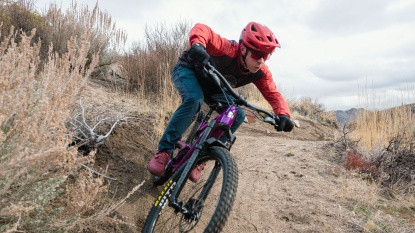 Lightweight vs full power e mountain bike choice
Lightweight vs full power e mountain bike choice
Lightweight or full-power electric bike, you are bound to have a good time.
Credit: Matt Lighthart
Frame Material
Similar to traditional mountain bikes, e-bikes are available in alloy or carbon frames. Carbon offers lighter weight and improved vibration damping, which are significant advantages in e-mountain biking. Carbon frames can noticeably reduce weight, especially considering the downtube and motor area construction. However, weight savings come at a higher price. For weight-conscious riders, a carbon frame may be worth the investment. For those less concerned with weight, an alloy frame offers a more budget-friendly option and less worry about scratches or scrapes.
Which Wheel Size is Right for You?
Most e-MTBs utilize 29″ wheels to support the larger bike platform and maximize rollover capability. Some models offer mullet setups, combining a 29″ front wheel with a 27.5″ rear wheel. Wheel size choice depends on the specific bike, as not all manufacturers offer both variations within the same model. Some bikes include flip chips to accommodate different rear wheel sizes. Mullet setups offer geometry advantages, particularly shorter chainstays, enhancing playfulness and agility in the rear end. The decision boils down to personal preference: stability and rollover efficiency versus livelier handling and maneuverability.
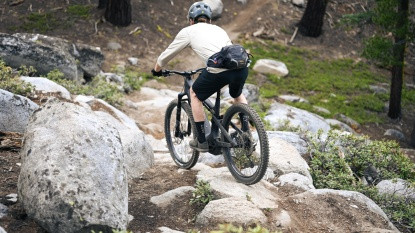 Wheel size choice for e mountain bikes
Wheel size choice for e mountain bikes
Lively and playful or controlled and balanced, finding the right wheel choice is up to you.
Credit: Abriah Wofford
How Much Travel Do You Need?
Suspension travel dictates a bike’s riding capabilities and intended use. Bikes with under 140mm of travel are best for cross-country and trail riding, ideal for long days in the saddle. The 140mm to 160mm travel range is the most popular for e-MTBs, striking a balance. Travel exceeding 160mm is typically for downhill-focused riding on very challenging terrain. Most e-MTBs fall into the all-mountain category with 140-160mm travel, offering versatility for both uphill and downhill performance. Well-designed e-MTBs can handle more travel without compromising uphill efficiency due to pedal-assist motors.
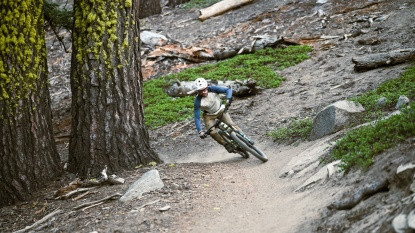 Travel choice for e mountain bikes depends on terrain
Travel choice for e mountain bikes depends on terrain
Choosing the right travel is dependent on your terrain and riding style, but it’s hard to go wrong these days with the advancements in geometry and design.
Credit: Abriah Wofford
Analysis and Test Results
We meticulously evaluated every aspect of each e-bike’s performance, scoring them across downhill performance, climbing performance, range, power output, and e-bike controls. This comprehensive analysis provides valuable insights to assist you in your e-bike buying quest.
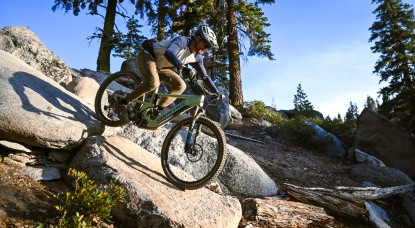 Testing e mountain bikes to the limit
Testing e mountain bikes to the limit
When we test bikes, we try to take them to their limits and ride them for weeks to tease out the differences in handling and performance.
Credit: Abriah Wofford
What’s the Best Value?
Mountain bikes, especially electric models, can be expensive. While higher prices often correlate with higher performance, there are exceptions. The Aventon Ramblas, for example, offers near-top-tier performance at a significantly lower price due to Aventon’s direct-to-consumer sales model. Similarly, the YT Decoy 29 Core 4 and Canyon Spectral:ON CF8, while not inexpensive, provide carbon frames, excellent components, and exceptional trail performance at a fraction of the cost of comparable bikes from larger brands.
Sharing the stoke is an integral part of e-bike testing.
Credit: Laura Casner
What is an E-Bike?
Electric bikes come in various types and classifications. Most e-mountain bikes, including those tested here, are Class 1, providing power only while pedaling and limited to 20 mph in the US. These e-bikes resemble traditional mountain bikes but integrate batteries and motors into the frame. The pedal-assist motor, typically located around the bottom bracket, provides support to the drivetrain as you pedal. Most systems offer multiple support levels to amplify rider input.
We tested full-suspension all-mountain/trail models with similar suspension travel, geometry, and wheel/tire sizes. The added battery and motor increase e-bike weight to around 50 lbs, approximately 20 pounds heavier than non-e-bikes. This added weight makes them harder to ride without motor assistance, with the Trek Fuel EXe being a lighter exception at just over 45 pounds.
E-MTBs are legally and responsibly rideable in many US locations. Always check local land management regulations regarding e-bike trail access. Motorized-legal trails are generally open to e-MTBs, and we utilized OHV trails near Lake Tahoe for testing.
It’s important to acknowledge the added complexity of motors, batteries, and controls, which introduces potential points of failure. Research warranty coverage and purchase from knowledgeable local dealers when possible for support if issues arise.
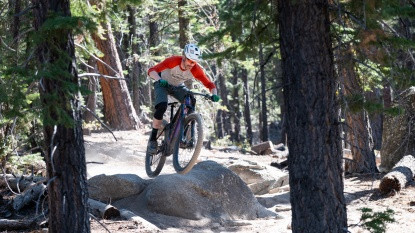 Modern e mountain bike descent performance
Modern e mountain bike descent performance
Modern electric mountain bikes like the Trek Rail 9.7 perform very well on the descents.
Credit: Laura Casner
Downhill Performance
Downhill performance is our highest weighted metric, as we believe it’s the most crucial aspect of an e-bike’s trail capability. Testers rode each bike extensively on various terrains, from fast flow trails to technical low-speed sections, evaluating component spec, geometry, and frame design contributions to downhill performance. All tested e-bikes were enjoyable downhill, each with unique characteristics.
The Trek Fuel EXe emerged as a tester favorite for its versatile downhill performance, feeling “a lot like a regular trail bike.” Its lighter weight and nimble handling, combined with 140/150mm travel, provide capability and playfulness. While not the most aggressive, it’s exceptionally well-handling and feels most like a traditional bike. The full-power Turbo Levo Comp was another top performer downhill, boasting 150/160mm of travel, balanced weight, and responsive handling for confident performance on diverse terrain. Its adjustable geometry allows riders to tailor handling to their style and preferences.
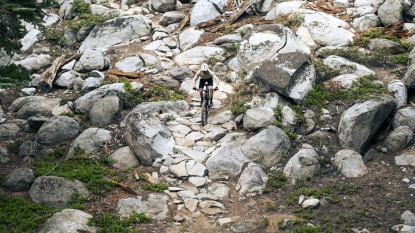 Turbo Levo Comp adjustable geometry e mountain bike
Turbo Levo Comp adjustable geometry e mountain bike
The Turbo Levo Comp’s adjustable geometry allows the rider to make dramatic changes to suit their needs and preferences.
Credit: Abriah Wofford
The Santa Cruz Heckler SL combines 150/160mm travel, modern trail geometry, and mixed wheel sizes for a versatile, lightweight ride, performing well across speeds and terrains. It’s stable at speed and in steep terrain, yet maneuverable at lower speeds and on moderate trails. The Canyon Spectral:ON CF 8 offers well-rounded downhill performance with moderate modern geometry and 155/150mm travel. Surprisingly nimble for its weight, it remains stable and confidence-inspiring at high speeds and on steep slopes.
YT’s Decoy 29 also impressed with its versatile downhill performance. With 145mm rear travel, 29-inch wheels, and modern geometry, it’s a capable descender comfortable across various terrains. Similar to the Trek Fuel EXe and Specialized Levo, it feels like a responsive and agile trail bike capable of aggressive riding.
 YT Decoy 29 versatile downhill e mountain bike
YT Decoy 29 versatile downhill e mountain bike
The YT Decoy 29 is s uper versatile model that won’t hold you back on the descents. This bike is ready for anything.
Credit: Laura Casner
The Commencal Meta Power TR Ride was also a blast downhill. Its long, slack geometry, reminiscent of enduro bikes, excels at speed and in rough terrain, while also remaining fun on flow trails and mellower terrain. The Trek Rail 9.7, a 150mm travel 29er with modern geometry, impressed with its planted, ground-hugging feel and eagerness to accelerate. Its flip chips allow geometry adjustments for terrain and rider preference.
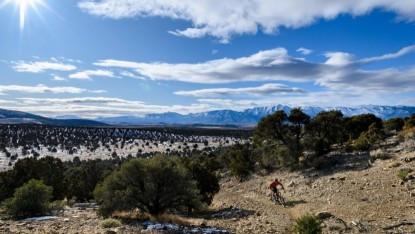 E bike pedal assist fun climbs and descents
E bike pedal assist fun climbs and descents
Pedal assistance sure does make those climbs easier, and in some cases, just as fun as the descents.
Credit: Laura Casner
Climbing Performance
E-bikes aim to make uphill riding easier, and some testers even find climbing nearly as enjoyable as descending with pedal assist. Climbing on an e-MTB differs from traditional bikes; they maintain higher uphill speeds, shifting the climbing dynamic towards power and momentum over finesse. Their heavier weight provides excellent traction, keeping them planted, and suspension compression/climbing switches can be left open to maximize active rear suspension benefits. Geometry, handling, and power output all influence climbing performance, which we evaluated extensively during uphill laps for more downhill runs.
The YT Decoy 29 Core 4 is a highly competent climber. Its powerful Shimano EP8 motor and dialed trail geometry contribute to comfortable and maneuverable climbing, tackling diverse trail features. The Specialized Turbo Levo Comp is another uphill favorite, with its refined motor system eliminating abrupt power cutoff issues of earlier models. Its powerful motor and geometry excel at scrambling up various climbs while maintaining maneuverability. However, its adjustable geometry can significantly alter handling characteristics.
 Trek Rail capable e bike climber
Trek Rail capable e bike climber
The trek Rail isn’t exactly agile, but it is plenty capable of powering up and over anything in its path.
Credit: Laura Casner
The Canyon Spectral:ON CF 8 also climbs effectively. Its moderate trail geometry and powerful EP8 motor enable riders to conquer challenging climbs. Similarly, the YT Decoy, with the same motor system and supportive 4-bar suspension, makes climbing nearly as enjoyable as descending. Its smaller rear wheel and balanced weight enhance maneuverability for a heavy, long e-bike.
The Trek Fuel Exe and Specialized Levo SL are the most agile climbers in the test. Testers noted the importance of line choice, requiring more precision than full-power bikes. Flip chips on these models allowed geometry adjustments, with the high setting generally preferred for climbing and everyday trail riding, and low settings better suited for fast descents and aggressive riding.
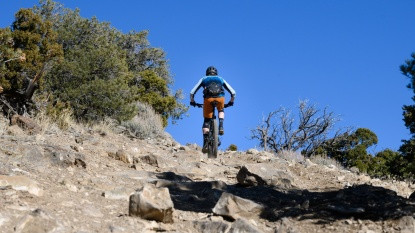 Turbo Levo SL lightweight e bike climber
Turbo Levo SL lightweight e bike climber
The Turbo Levo SL doesn’t pack the same punch as the full-power models but its lighter weight and middle-of-the-road geometry handle well on the climbs.
Credit: Laura Casner
The Santa Cruz Heckler SL stands out in climbing. With less power and torque than full-power models, it requires more rider effort, despite not being significantly lighter. However, its comfortable geometry, responsive handling, and drag-free drivetrain appeal to riders who enjoy working harder for their descents.
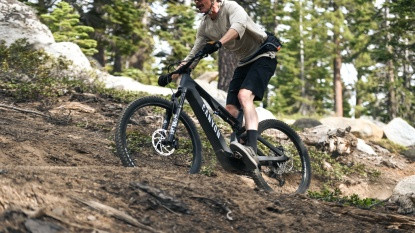 Spectral ON CF 8 long range battery e mountain bike
Spectral ON CF 8 long range battery e mountain bike
The wide downtube of the Spectral:ON houses a whopping 900Wh battery that gives it the longest range of any model we’ve tested.
Credit: Abriah Wofford
Distance Range
E-bike range refers to the distance achievable on a single charge, influenced by factors like battery capacity, rider weight, terrain, conditions, and temperature. Battery capacities range from 625-700Wh, with 900Wh options emerging and technology constantly improving. Larger batteries theoretically offer longer range, but real-world conditions impact performance.
To compare range, we had a single tester ride each bike in its highest support mode on a consistent course until battery depletion, recording distance and vertical gain. We used Garmin power meter pedals to standardize rider input, maintaining sufficient effort to engage torque sensors without artificially extending range.
The Canyon Spectral:ON CF 8, boasting a 900Wh battery, led in range. It covered 38.5 miles with 5,292 feet of elevation change. Real-world rides exceeding 30 miles with over 6,000 feet of climbing were easily achieved without battery concerns.
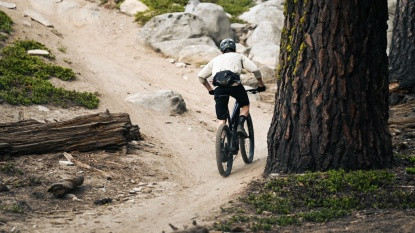 Turbo Levo Comp long range e mountain bike
Turbo Levo Comp long range e mountain bike
Want to go on long rides with lots of vert? The Turbo Levo Comp and its 700Wh battery is a good choice.
Credit: Abriah Wofford
While Specialized no longer leads in battery size, the Turbo Levo Comp, with its 700Wh battery, remains competitive. It achieved 33.1 miles and over 5,000 vertical feet in our standardized test. Testers completed 30+ mile rides with 6k of vertical using mixed trail and turbo modes before battery depletion.
The Commencal Meta Power TR, with a 630Wh battery and Shimano EP8 motor, covered over 26 miles with nearly 5,000 vertical feet. Trail rides around 30 miles with 6k of climbing were also achieved. The Trek Rail 9.7, with a 625Wh battery, impressively traveled 28.95 miles, exceeding expectations given its slightly smaller battery than the Levo.
The Aventon Ramblas, with a 708Wh battery and A100 motor, achieved 30.1 miles and 5980 feet of ascent. The YT Decoy 29 Core 4, with a 540Wh battery, achieved 23.2 miles, a respectable result considering its smaller battery. Rides over 24 miles and 4,000+ vertical feet were achieved with remaining battery capacity.
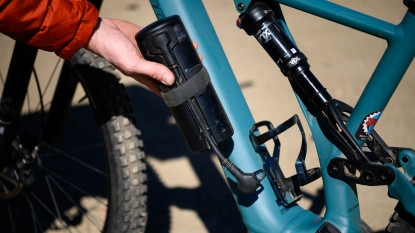 Levo SL range extender battery
Levo SL range extender battery
The Range Extender battery fits into the bottle cage of the Levo SL adding 160Wh to the 320Wh internal battery.
Credit: Laura Casner
The Trek Fuel EXe, with a 360Wh battery, had the shortest range, covering 19 miles and about 1700 vertical feet on its high power setting. However, using Eco mode, rides exceeding 30 miles with over 5,000 vertical feet were possible.
Lower power output usage extends e-bike range. Drive unit smartphone apps allow customization of support settings for range optimization. Specialized’s Mission Control app offers route-based power management and heart rate-based assist adjustment.
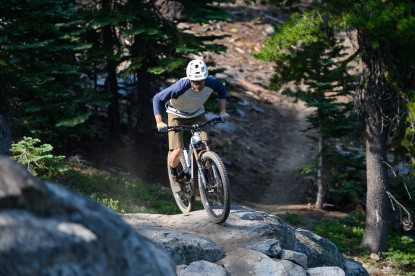 E bike motor system comparison
E bike motor system comparison
The different motor systems are all pretty good but differ slightly. The new Shimano EP8 on the Decoy 29 works very well.
Credit: Laura Casner
Power Output
E-bikes transfer motor power to the drivetrain to assist pedaling. While systems function similarly, subtle power output differences create distinct riding experiences. All tested systems are Class 1, limited to 20 mph assist, and offer multiple support modes. We evaluated power output based on rider feel through blind testing, revealing discernible differences between models.
The Specialized 2.2 motor system, with 90Nm of torque and 565 watts peak output, felt slightly more powerful than others, except for the Aventon Ramblas. The Ramblas’ Aventon A100 motor delivers exceptional power, conquering challenging climbs. The A100 is advertised at 100Nm of torque.
Shimano’s EP8 motor, found on the Canyon, YT, Santa Cruz, and Commencal, works great and provides plenty of power for blasting around the trails.
Credit: Abriah Wofford
Despite an 85Nm torque rating, the Bosch Performance CX motor on the Trek Rail 9.7 felt among the most powerful, delivering smooth, consistent, and strong power for a fast ride feel. The Shimano EP8 motor on the Commencal Meta Power TR, Canyon Spectral:ON CF 8, and YT Decoy 29 Core 4, also rated at 85Nm torque, offers ample power with smooth and consistent delivery, though slightly less forceful than the Bosch unit. The Shimano E-Tube app allows customizable output settings.
The Trek Fuel EXe, in a different category, utilizes the smaller TQ HPR-50 motor with 50Nm max torque and 300 Watts power, roughly half that of competitors. Power delivery is impressively smooth, but less forceful than full-power models, requiring more rider input and potentially appealing to riders seeking a greater workout. The Santa Cruz Heckler SL uses the Fazua Ride60 motor, rated at 60Nm torque, but feels less punchy than the Trek’s TQ motor.
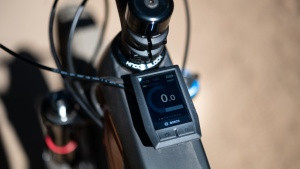 Trek Rail 9.7 handlebar controls
Trek Rail 9.7 handlebar controls
The handlebar-mounted control unit on the Trek Rail 9.7.
Credit: Laura Casner
 Trek Rail 9.7 handlebar controls
Trek Rail 9.7 handlebar controls
The top tube-mounted display on the Trek Rail 9.7 is pretty slick, although it can be hard to view while riding.
Credit: Laura Casner
 Trek Rail 9.7 handlebar controls
Trek Rail 9.7 handlebar controls
The Bosch interface has a control unit by the left grip and a small bike computer-esque display.
Credit: Laura Casner
E-Bike Controls
E-bike controls, the primary user interface, are a rated element, though less heavily weighted. Motor systems vary in controls. We evaluated user-friendliness, shifter ergonomics, display readability, and charging ease. Smartphone apps accompany each system, allowing fine-tuning of motor support, custom settings, battery monitoring, and more. While not essential for e-MTB use, tech-savvy riders or those seeking personalization may find apps beneficial.
The Commencal Meta Power TR Team scored well in controls, featuring a small stem-mounted digital display, Shimano’s ergonomic shifter, and the readable SC-EM800 handlebar display. The YT Decoy 29 and Canyon Spectral:ON CF 8 use similar controls and displays. Both have accessible controls and stem-mounted displays, but the E7000 display lacks the Commencal’s color-coded output settings. Customizable output settings are available via the user-friendly Shimano e-Tube app.
The Shimano E7000 display, it may be small and somewhat hard to read, but it’s far better than no display at all.
Credit: Jenna Ammerman
Trek’s Rail 9.7 features a Bosch Kiox display and controls. While controls are intuitive, ergonomics were less optimal. The top tube-mounted display, while visually appealing, is difficult to view while riding and may be overly complex. However, it likely offers customizable features we didn’t fully explore. The Specialized Turbo Levo Comp scores lower in controls due to the lack of a handlebar display. Controls are ergonomic, but the top tube LED display is less easily readable while riding, though functional. Newer Bosch controllers are wireless, creating a cleaner cockpit.
E-bikes are a ton of fun to ride. Some are better than others…
Credit: Jenna Ammerman
Conclusion
The e-mountain bike market offers numerous excellent options, with new models frequently emerging. Choosing the best e-MTB for your needs can be challenging. This detailed comparative review aims to guide you in finding the ideal model for your riding style, terrain, and budget. We will continuously update this review as new bikes and e-MTB technology evolve.
For complete bike outfitting, we’ve also tested great bike gear including mountain bike shoes, mountain bike helmets, and more.

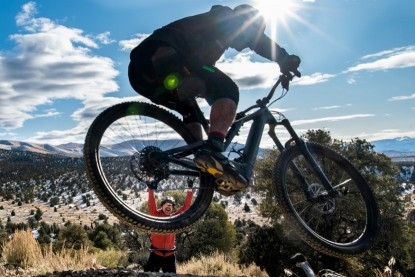 Sharing e bike stoke
Sharing e bike stoke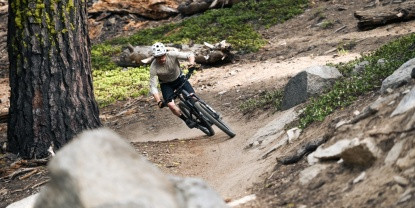 Shimano EP8 e bike motor
Shimano EP8 e bike motor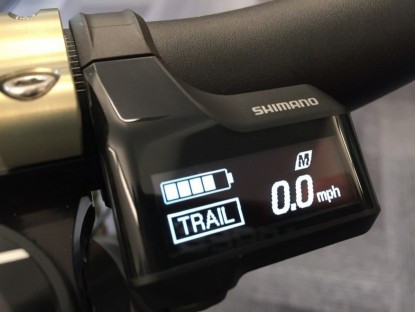 Shimano E7000 e bike display
Shimano E7000 e bike display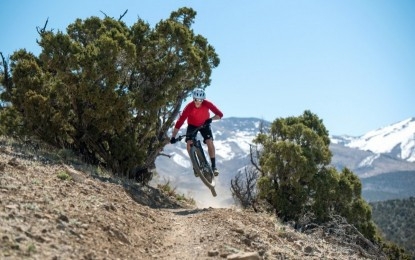 E bikes are fun to ride
E bikes are fun to ride